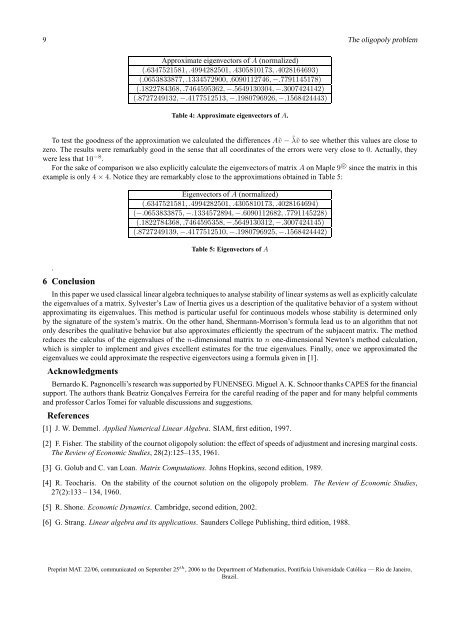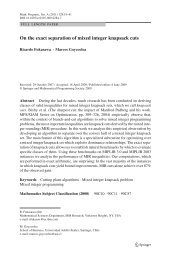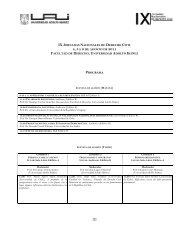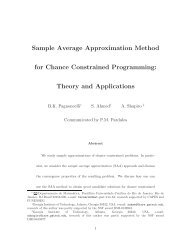Stability analysis of the oligopoly problem and variations Bernardo ...
Stability analysis of the oligopoly problem and variations Bernardo ...
Stability analysis of the oligopoly problem and variations Bernardo ...
Create successful ePaper yourself
Turn your PDF publications into a flip-book with our unique Google optimized e-Paper software.
9 The <strong>oligopoly</strong> <strong>problem</strong><br />
Approximate eigenvectors <strong>of</strong> A (normalized)<br />
(.6347521581, .4994282501, .4305810173, .4028164693)<br />
(.0653833877, .1334572900,.6090112746, −.7791145178)<br />
(.1822784368, .7464595362, −.5649130304, −.3007424142)<br />
(.8727249132, −.4177512513, −.1980796926, −.1568424443)<br />
Table 4: Approximate eigenvectors <strong>of</strong> A.<br />
To test <strong>the</strong> goodness <strong>of</strong> <strong>the</strong> approximation we calculated <strong>the</strong> differences Aṽ − ˜λṽ to see whe<strong>the</strong>r this values are close to<br />
zero. The results were remarkably good in <strong>the</strong> sense that all coordinates <strong>of</strong> <strong>the</strong> errors were very close to 0. Actually, <strong>the</strong>y<br />
were less that 10 −8 .<br />
For <strong>the</strong> sake <strong>of</strong> comparison we also explicitly calculate <strong>the</strong> eigenvectors <strong>of</strong> matrix A on Maple 9 c○ since <strong>the</strong> matrix in this<br />
example is only 4 × 4. Notice <strong>the</strong>y are remarkably close to <strong>the</strong> approximations obtained in Table 5:<br />
.<br />
6 Conclusion<br />
Eigenvectors <strong>of</strong> A (normalized)<br />
(.6347521581, .4994282501, .4305810173, .4028164694)<br />
(−.0653833875, −.1334572894, −.6090112682, .7791145228)<br />
(.1822784368, .7464595358, −.5649130312, −.3007424145)<br />
(.8727249139, −.4177512510, −.1980796925, −.1568424442)<br />
Table 5: Eigenvectors <strong>of</strong> A<br />
In this paper we used classical linear algebra techniques to analyse stability <strong>of</strong> linear systems as well as explicitly calculate<br />
<strong>the</strong> eigenvalues <strong>of</strong> a matrix. Sylvester’s Law <strong>of</strong> Inertia gives us a description <strong>of</strong> <strong>the</strong> qualitative behavior <strong>of</strong> a system without<br />
approximating its eigenvalues. This method is particular useful for continuous models whose stability is determined only<br />
by <strong>the</strong> signature <strong>of</strong> <strong>the</strong> system’s matrix. On <strong>the</strong> o<strong>the</strong>r h<strong>and</strong>, Shermann-Morrison’s formula lead us to an algorithm that not<br />
only describes <strong>the</strong> qualitative behavior but also approximates efficiently <strong>the</strong> spectrum <strong>of</strong> <strong>the</strong> subjacent matrix. The method<br />
reduces <strong>the</strong> calculus <strong>of</strong> <strong>the</strong> eigenvalues <strong>of</strong> <strong>the</strong> n-dimensional matrix to n one-dimensional Newton’s method calculation,<br />
which is simpler to implement <strong>and</strong> gives excellent estimates for <strong>the</strong> true eigenvalues. Finally, once we approximated <strong>the</strong><br />
eigenvalues we could approximate <strong>the</strong> respective eigenvectors using a formula given in [1].<br />
Acknowledgments<br />
<strong>Bernardo</strong> K. Pagnoncelli’s research was supported by FUNENSEG. Miguel A. K. Schnoor thanks CAPES for <strong>the</strong> financial<br />
support. The authors thank Beatriz Gonçalves Ferreira for <strong>the</strong> careful reading <strong>of</strong> <strong>the</strong> paper <strong>and</strong> for many helpful comments<br />
<strong>and</strong> pr<strong>of</strong>essor Carlos Tomei for valuable discussions <strong>and</strong> suggestions.<br />
References<br />
[1] J. W. Demmel. Applied Numerical Linear Algebra. SIAM, first edition, 1997.<br />
[2] F. Fisher. The stability <strong>of</strong> <strong>the</strong> cournot <strong>oligopoly</strong> solution: <strong>the</strong> effect <strong>of</strong> speeds <strong>of</strong> adjustment <strong>and</strong> incresing marginal costs.<br />
The Review <strong>of</strong> Economic Studies, 28(2):125–135, 1961.<br />
[3] G. Golub <strong>and</strong> C. van Loan. Matrix Computations. Johns Hopkins, second edition, 1989.<br />
[4] R. Teocharis. On <strong>the</strong> stability <strong>of</strong> <strong>the</strong> cournot solution on <strong>the</strong> <strong>oligopoly</strong> <strong>problem</strong>. The Review <strong>of</strong> Economic Studies,<br />
27(2):133 – 134, 1960.<br />
[5] R. Shone. Economic Dynamics. Cambridge, second edition, 2002.<br />
[6] G. Strang. Linear algebra <strong>and</strong> its applications. Saunders College Publishing, third edition, 1988.<br />
Preprint MAT. 22/06, communicated on September 25 th , 2006 to <strong>the</strong> Department <strong>of</strong> Ma<strong>the</strong>matics, Pontifícia Universidade Católica — Rio de Janeiro,<br />
Brazil.

















